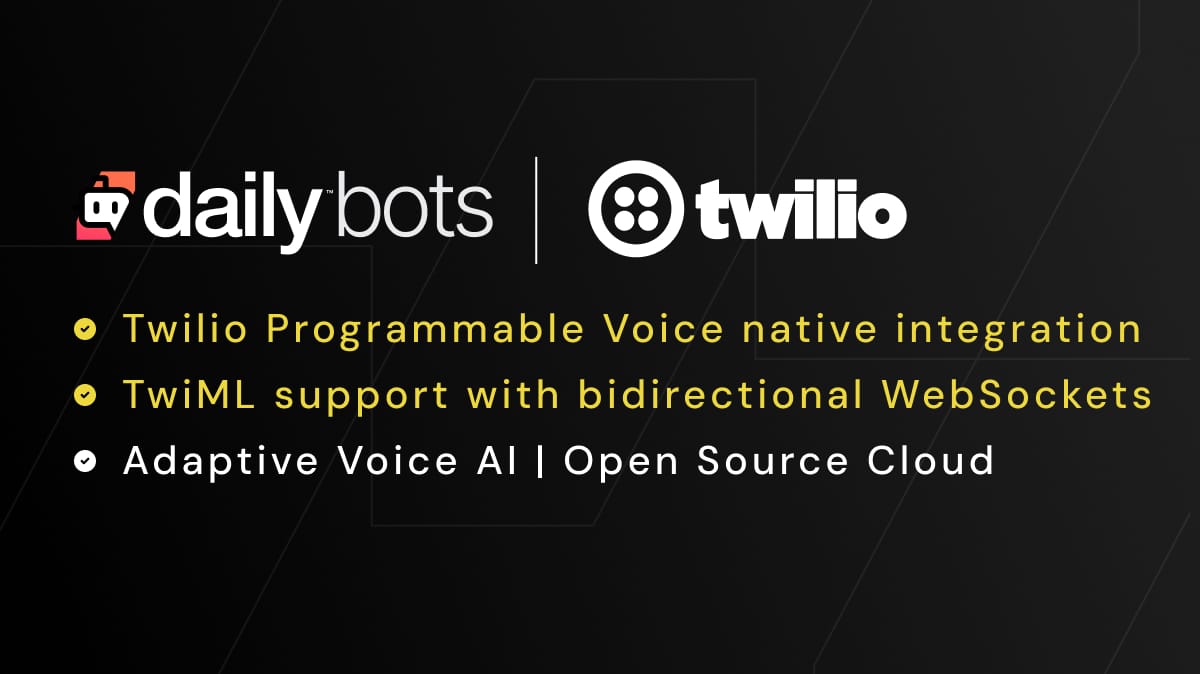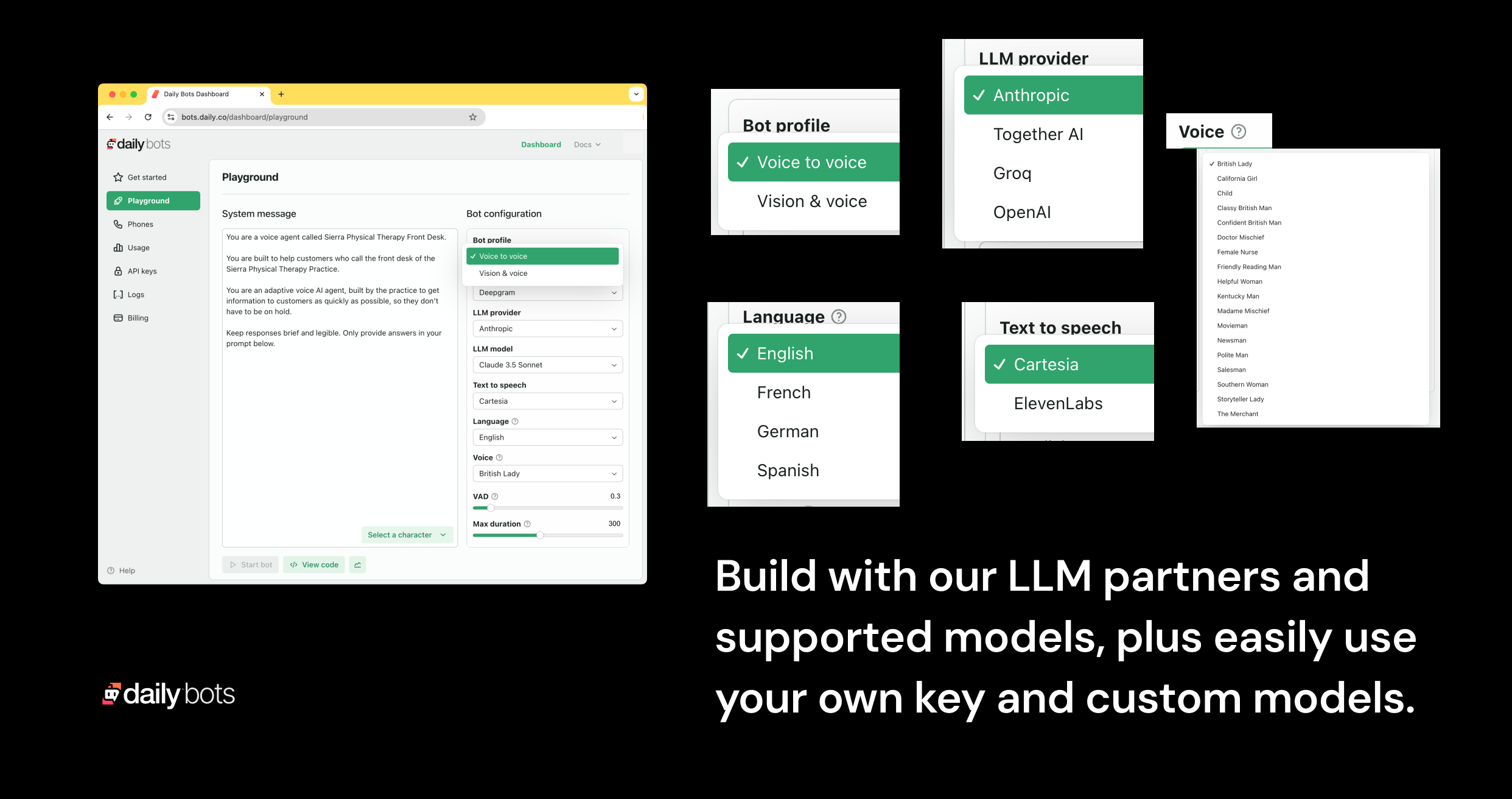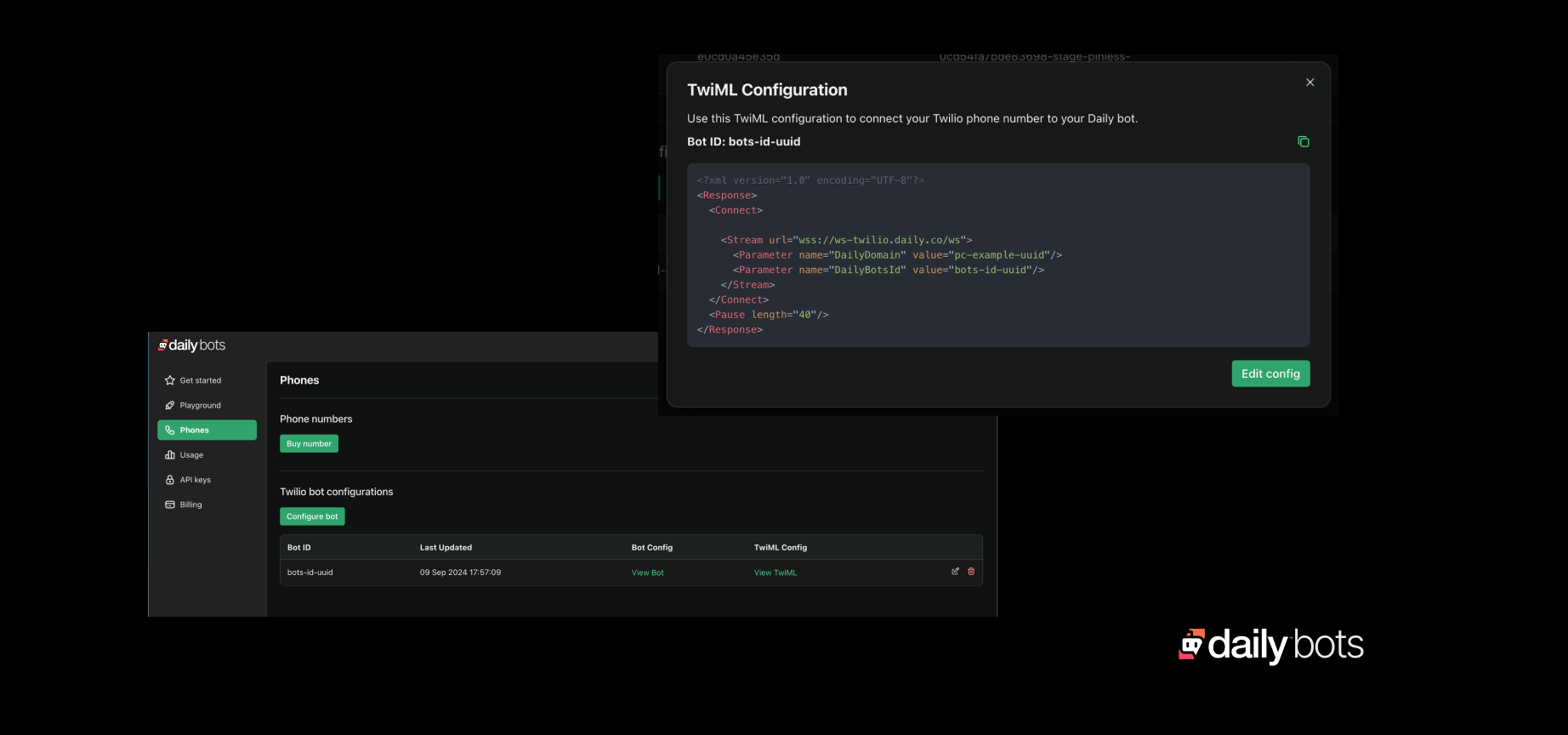
Today we’re excited to share our Twilio integration in Daily Bots, where developers build adaptive conversational voice AI on the world’s leading global real-time infrastructure and open source SDKs.
Daily Bots is architected to give enterprises and developers the flexibility they need as they build adaptive voice AI. Now you can use your Twilio numbers and voice workflows directly with real-time conversational voice AI and LLM workflows powered by Daily Bots.
- With this release, Daily Bots natively supports Twilio WebSockets.
- Right in your Daily Bots dashboard (or via REST API), developers can create real-time voice AI agents configured with a TwiML code output.
- Attach the generated TwiML code output to a Twilio Bin and use it in any Twilio workflow such as Twilio Flex, Twilio Studio, and IVR. Support both dial-in and dial-out.
Daily Bots-powered agents are state-of-the-art, talking naturally in conversation, with ultra low latency, as they retrieve structured data using any LLM, for tasks like scheduling appointments, answering questions back-and-forth about a policy, completing intake, and triaging and routing more effectively.
Agents can be spun up and down as needed, to support goals like dynamic, streamlined operations and happier, engaged customers.
Start here, to try it out. Below we discuss real-time AI agents in voice workflows, how Daily Bots enables voice AI, and how the integration works.
Improving telephony workflows
Telephony is a bedrock of customer communications and omnichannel UX. Yet companies face what McKinsey calls a “a perfect storm of challenges,” including increasing call volumes and staffing issues.
Meanwhile, today’s customers are vocal about hold times, phone trees, voice mail, and unhappy experiences.
Over the last year, step function improvements in a suite of AI technologies — spanning orchestration, function calling, LLM and voice models, and more — have enabled agents that can bring AI’s structured data insights into real-time conversation.
Learn how Daily Bots brings state-of-the-art conversational abilities and flexibility:
- Avoid vendor lock in. The Daily Bots hosted offering is built on top of open source client SDKs and Pipecat, the fastest growing Open Source voice AI framework.
- Better customize for enterprise workflows. Daily Bots leverages function calling, tool use, and structured data generation. Integrate with headless knowledge base APIs and existing back-end systems.
- Run on proven infrastructure. We have managed infrastructure at global scale since 2016, with 99.99% uptime across 75 points of presence, around the world with SOC 2 Type 2 certification and HIPAA and GDPR compliance. Daily’s edge network delivers 13ms median first-hop latency to a coverage footprint of 5 billion end users.
- Deploy into your VPCs or private networks as needed. Daily can help you with on premises or VPC infrastructure if your use case requires. Our product and engineering leadership has extensive experience working with customers in high-security contexts.

Right in your dashboard, you can build unified voice-to-voice applications with any LLM. Daily’s modular approach provides both a best-in-class developer experience and simple, transparent billing and pricing. Our partners include leading AI model providers including Anthropic, Cartesia, Deepgram, OpenAI and Together AI; or you can bring your own keys and use your preferred models (including custom models).
With this enablement, enterprise customers can flexibly use Daily Bots across their technology stack. Today’s release furthers that goal, allowing you to leverage your existing Twilio Voice assets together with the Daily Bots adaptive voice feature set.
Supporting Twilio Voice Workflows, building on Twilio WebSockets
Twilio is the leader in programmable voice, supporting over 10 million developers from startups to the enterprise. It has developed a complete suite of voice products — like Twilio Flex, Twilio Studio, and hosted Twilio apps — which lets its customers build across use cases like IVR, alerts and notifications, call tracking, and more.
Telephony is integral to voice conversations, and Daily Bots has always supported a full suite of telephone and SIP features. With this release, your customers can dial your Twilio number and talk to a Daily Bot. Use cases we have seen include:
- Business messaging platforms. A platform uses Twilio Studio to provision phone numbers for trades and services. When a customer dials the numbers, instead of being connected to a front desk or getting voice mail, they immediately talk to an AI agent, who can complete scheduling. The agent is able to ask questions in a conversation back-and-forth with the customer. Based on some qualifying questions, the agent can book an appointment immediately and/or route the customer for elevated support.
- Professional services platforms. To help patients achieve better outcomes after care, a provider's office pings them across channels, to check in. While outreach like SMS can remind a patient to call, an AI agent can handle this much more flexibly. The AI agent calls the patient and based on responses in conversation, can flag the patient for further follow up.
- Industries like financial services that build Twilio workflows in conjunction with Google Dialogflow extensively are transitioning previous-generation NLP workflows to AI conversational voice. Today’s LLMs deliver higher customer satisfaction, percentage of calls handled without human intervention, and call deflection metrics, at lower cost than older call center technologies.
You can learn more about how to build all of these things in the Daily Bots docs.
How it works
Daily Bots generates Twilio TwiML code for you. TwiML is the Twilio Markup Language. Developers use TwiML to build Twilio workflows. You can create a Daily Bots voice AI session wherever you use TwiML.
WebRTC and WebSockets infrastructure
Daily Bots supports both WebRTC and WebSockets depending on your use case:
- Daily Bots uses WebSockets for Twilio – and other telephony and SIP – connectivity. Twilio’s WebSockets implementation is robust and delivers good performance for two-way audio streams over server-to-server network connections.
- Daily Bots sessions can also run on top of Daily’s global WebRTC infrastructure. WebRTC provides lower-latency, higher-bandwidth, higher-quality connectivity and is the best protocol for delivering audio directly to end-user devices such as web browsers and mobile phones. Daily Bots sessions can be accessed by Daily WebRTC transport, PSTN telephone dial-in, telephone dial-out, Web browser apps, and native apps on iOS, Android, and other platforms. WebRTC also supports video and multi-participant real-time AI applications.
Developer Workflow
To set up a Twilio + Daily Bots integration:
- Configure a Daily Bot using the Daily Bots dashboard. This generates both a Daily Bot configuration and TwiML code.
- Open your Twilio console and create a TwiML Bin. Save the bin and assign it to a phone number in the Twilio console.
- You can create a Daily Bot session in any of your Twilio workflows, using this TwiML code.

For dial-in, calling the Twilio number automatically routes to the corresponding Daily Bot.
For dial-out, use the Twilio REST API or Twilio CLI to call the target phone number. Learn more here.
Get Started
Given the centrality of voice, leveraging the benefits of real-time conversational voice AI is a key consideration for our enterprise customers and developer community.
Get started here. Below are a few more links if you'd like to dive in more. We're excited to partner with you.
- Sign up, $10 in credits, https://bots.daily.co
- Visit the developer docs
- Contact sales for enterprise needs
- Watch a video on how to configure Daily Bots and Twilio Voice
Follow us on social. Our technical cofounder Kwindla regularly posts about real-time conversational voice AI. You can follow Daily on LinkedIn and Twitter.



